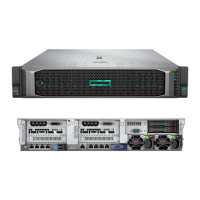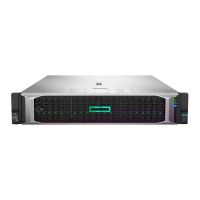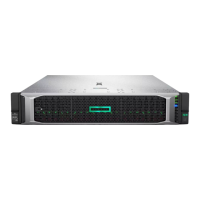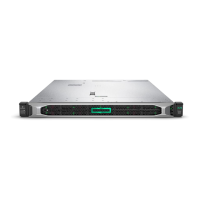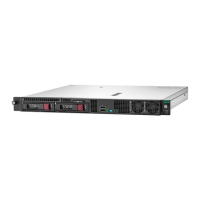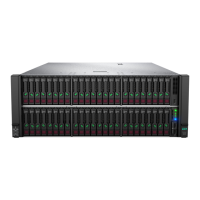Item Description Definition
5 Maximum memory speed
2133 MT/s
2400 MT/s
2666 MT/s
6 CAS latency
P = CAS 15-15-15
T = CAS 17-17-17
U = CAS 20-18-18
V = CAS 19-19-19 (for RDIMM, LRDIMM)
V = CAS 22-19-19 (for 3DS TSV LRDIMM)
7 DIMM type
R = RDIMM (registered)
L = LRDIMM (load reduced)
E = Unbuffered ECC (UDIMM)
For more information about product features, specifications, options, configurations, and compatibility, see
the product QuickSpecs on the Hewlett Packard Enterprise website (http://www.hpe.com/info/qs).
Memory configurations
To optimize server availability, the server supports the following Advanced Memory Protection (AMP)
mode:
Advanced ECC—Provides up to 4-bit error correction. This mode is the default option for this server.
AMP options are configured in the BIOS/Platform Configuration (RBSU). For more information, see the
UEFI System Utilities User Guide for HPE ProLiant Gen10 Servers and HPE Synergy on the Hewlett
Packard Enterprise website.
Advanced ECC memory configuration
Advanced ECC memory is the default memory protection mode for this server. Standard ECC can correct
single-bit memory errors and detect multi-bit memory errors. When multi-bit errors are detected using
Standard ECC, the error is signaled to the server and causes the server to halt.
Advanced ECC protects the server against some multi-bit memory errors. Advanced ECC can correct
both single-bit memory errors and 4-bit memory errors if all failed bits are on the same DRAM device on
the DIMM.
Advanced ECC provides additional protection over Standard ECC because it is possible to correct certain
memory errors that would otherwise be uncorrected and result in a server failure. Using HPE Advanced
Memory Error Detection technology, the server provides notification when a DIMM is degrading and has a
higher probability of uncorrectable memory error.
DIMM population information
For specific DIMM population information, see the DIMM population guidelines on the Hewlett Packard
Enterprise website (http://www.hpe.com/docs/memory-population-rules).
Identifying the processor type
The processor type installed in the server is briefly displayed during POST. To view this information and
additional processor specifications, do the following:
68 Memory configurations

